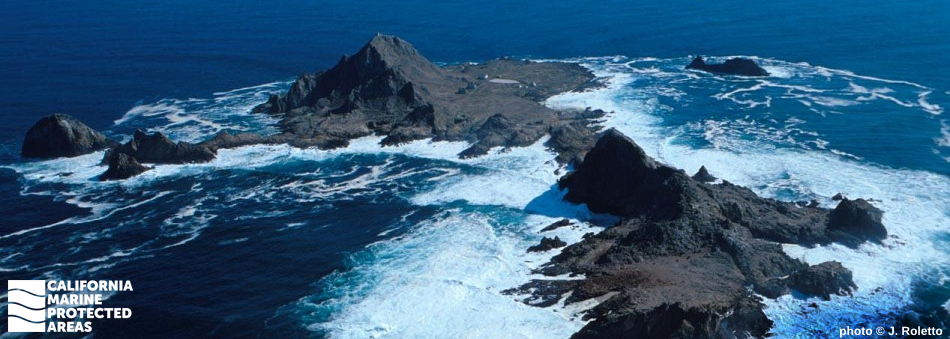
Overview
The Farallon Islands are a rugged and biologically diverse archipelago sitting 30 miles west of the Golden Gate Bridge in the Pacific Ocean. Aptly named the Farallones, the Spanish word meaning steep rocks or cliffs, the remote islands are exposed to the wind and waves of the open ocean and, aside from large numbers of seabirds and marine mammals, are quite barren on land.
There are three marine protected areas (MPAs) in the waters around Southeast Farallon Island, including Southeast Farallon Island State Marine Reserve (SMR), Southeast Farallon Island State Marine Conservation Area (SMCA), and Southeast Farallon Island Special Closure. The SMR protects more than five square miles of sandy beaches, rocky shores, surfgrass, and sandy and rocky seafloor habitat from shore to greater than 230 feet in depth. The SMCA protects nearly 13 square miles of sandy seafloor habitat from 130 to almost 400 feet in depth. The Special Closure protects a 300-foot narrow band of water surrounding the Southeast Farallon Island shoreline. Access is prohibited in most of the Special Closure to restrict boating activity in waters that surround important Steller and California sea lion, northern fur seal, and northern elephant seal haul out and rookery sites. Minimizing human activity here also helps protect 13 different species of seabirds including the common murre, western gull, Cassin's auklet, and pigeon guillemot - roughly 180,000 seabirds in all - that nest on these rocky islands.
The marine environment surrounding the island is highly productive and supports a rich species assemblage, including rocky reef-dwelling fishes, sharks, invertebrates, and marine mammals such as seals, sea lions, and orcas, along with migrating blue whales, humpback whales, and gray whales. Visitors to the Farallon Islands can participate in whale watching and salmon trolling within the SMCA.
Regulations
Southeast Farallon Island SMR
It is unlawful to injure, damage, take, or possess any living, geological, or cultural marine resource.
California Code of Regulations Title 14, Section 632(b)(53)(opens in new tab)
Southeast Farallon Island SMCA
It is unlawful to injure, damage, take, or possess any living, geological, or cultural marine resource, EXCEPT:
Recreational and commercial take of salmon by trolling is allowed.
California Code of Regulations Title 14, Section 632(b)(54)(opens in new tab)
Southeast Farallon Island Special Closure
Boating, access, and other specific activities are restricted. No person except employees of the California Department of Fish and Wildlife, United States Fish and Wildlife Service, National Oceanic and Atmospheric Administration, or United States Coast Guard during performance of their official duties, or unless permission is granted by the California Department of Fish and Wildlife, shall enter the area.
Additional restrictions exist that relate to boating speed limits, anchoring, seasonal closure, commercial diving operation exhaust procedures, and transit. See California Code of Regulations Title 14, Section 632(b)(55) for details.
California Code of Regulations Title 14, Section 632(b)(55)(opens in new tab)
Quick Facts
Southeast Farallon Island SMR
MPA size: 5.36 square miles
Shoreline span: 2.4 miles
Depth range: 0 to 238 feet
Habitat composition*:
- Rock: 4.73 square miles
- Sand/mud: 2.77 square miles
Southeast Farallon Island SMCA
MPA size: 12.95 square miles
Depth range: 130 to 382 feet
Habitat composition*:
- Rock: 1.59 square miles
- Sand/mud: 9.25 square miles
Southeast Farallon Island Special Closure
Special Closure size: 0.18 square miles
Depth range: 0 to 19 feet
Habitat composition*:
- Rock: 0.46 square miles
- Sand/mud: Less than 0.01 square miles
*Habitat calculations are based on three-dimensional area and may exceed the total MPA area listed above.